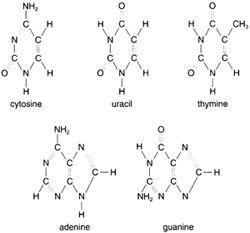The Search for the Substance of Heredity
There are several types of molecules in chromosomes. One such molecule is protein. For a long time, protein molecules were thought to be the bearers of heredity, the reason being that heredity appeared very complicated, and proteins are certainly also complicated. It seemed logical to suppose that protein bore the “secret” of heredity. While logic is a laudable process, it can serve only as a basis for directing investigation in science. |
| Figure 6-1 Deoxyribose differs from ribose in having one less oxygen atom. |
In 1868 Friedrich Miescher (1844-1895) separated nuclear material from the rest of the cell and discovered that after the protein portion of nuclei had been hydrolyzed by pepsin, a residue remained. The residue was determined to be an acid and was thus called nucleic acid.
During the 1920s, some aspects of the chemical structure of nucleic acids were determined. The essential structure involves a series of 5-carbon sugars (pentoses) linked in a chain and connected by phosphate groups. Attached to each sugar molecule are one or another of several types of bases. There are two types of nucleic acid, although both types have the same fundamental structure. In one type of nucleic acid, the sugar is ribose; in the other type, the sugar is deoxyribose. Deoxyribose differs from ribose in having one less oxygen
| Figure 6-2 A nucleotide is composed of a base, a sugar, and a phosphate |
atom in its molecule. The two types of nucleic acid are thus called deoxyribonucleic acid (DNA) and ribonucleic acid (RNA). The bases attached to the sugars in DNA are adenine, thymine, cytosine, and guanine; in RNA, the bases are adenine, uracil, cytosine, and guanine, uracil being in the place of DNA's thymine. These bases belong to two groups: adenine and guanine are purines, and cytosine and thymine are pyrimidines. Nucleic acids are composed of long chains of repeating units called nucleotides. A nucleotide is represented in figure 6-2.
The four types of nucleotides in DNA are as follows:
- adenine-deoxyribose-phosphate
- thymine-deoxyribose-phosphate
- cytosine-deoxyribose-phosphate
- guanine-deoxyribose-phosphate
- adenine-ribose-phosphate
- uracil-ribose-phosphate
- cytosine-ribose-phosphate
- guanine-ribose-phosphate
 |
| Figure 6-3 Five kinds of bases occur in nucleic acids: adenine, thymine, cytosine, and guanine for DNA, and adenine, cytosine, guanine, and uracil for RNA. Adenine and guanine are purines; cytosine, thymine, and uracil are pyrimidines. In pairing, a purine always links with a pyrimidine |
In 1928 a bacteriologist named Fred Griffith published a paper describing some work he had been doing with pneumococcus, the bacteria that causes pneumonia. Two strains of the organism were known: a virulent strain, which could cause disease, and an avirulent strain, which could not cause disease. When grown in culture, the virulent strain possessed a glistening outer smooth coat; it was thus designated with the letter S for "smooth." Under prolonged culture in the laboratory, the virulent strain lost its outer coat and became avirulent. Because the nonvirulent strain appeared rather rough under the microscope, it was designated with the letter R for “rough.” It was assumed that the outer capsule was responsible for causing the disease.
There are four smooa varieties of pneumococcus, each of which varies somewhat in its capsule. The four smooth varieties are designated as follows: S-I, S-II, S-III, and S-IV. Under prolonged culture, each of the smooth varieties loses its capsule and becomes incapable of causing disease; thus, there are four rough varieties, each based on the kind of capsule it previously possessed. The four rough varieties are designated as follows: R-I, R-II, R-III, and R-IV.
In Griffith’s experiments, when a suspension of R-11, for example, was injected into a mouse, the mouse did not get sick because the R-II form is avirulent. When a smooth variety-say S-III-was injected into a mouse, however, the mouse sickened and died. And when a suspension of S-III was first killed and then injected into a mouse, the mouse lived. So far, there is nothing surprising in Griffith’s findings. A surprising result did occur, however, when an R-type (avirulent) strain was mixed with a dead S-III (also avirulent) strain, and the mixture was injected into a mouse; the mouse sickened and died. Neither the R-type strain alone nor the killed S-type strain alone could cause disease; but a mixture of the two strains resulted in death. How could this have happened? The answer is that some genetic material from the dead S-III strain was taken up by the living R-II, thus transforming the R-II into an S-III!
 |
| Figure 6-4 Two bacteria connected by a conjugation tube. Genetic materia from one cell can migrate through the tube to the other cell |
It was later shown that such bacterial transformation did not require the presence of the mouse. In the 1940s 0.T. Avery, working at the Rockefeller Institute, fragmented the cells of pneumococcus and used centrifugation methods to separate the cell constituents into fractions. Thus, he had a fraction containing only protein and another fraction containing only DNA. When he put the protein fraction of a killed S-III strain with a living R-II strain, no change resulted. When he placed the DNA fraction of the killed S-III strain with the living R-II strain, however, the R-II took on the capacity of virulence. This provided clear, convincing evidence that DNA is the genetic material.
In 1952 Alfred Hershey and Margaret Chase’s work with the T-2 bacteriophage strongly reinforced the contention that DNA is the genetic material.
In time, DNA gained general acceptance as the substance of heredity; yet the structure of the DNA molecule remained very much a mystery. While it was clear that DNA consisted of a long chain of nucleotides linked together, the details of the linkage were elusive.




